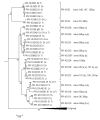Seven different genes encode a diverse mixture of isoforms of Bet v 1, the major birch pollen allergen
- PMID: 16820045
- PMCID: PMC1552068
- DOI: 10.1186/1471-2164-7-168
Seven different genes encode a diverse mixture of isoforms of Bet v 1, the major birch pollen allergen
Abstract
Background: Pollen of the European white birch (Betula pendula, syn. B. verrucosa) is an important cause of hay fever. The main allergen is Bet v 1, member of the pathogenesis-related class 10 (PR-10) multigene family. To establish the number of PR-10/Bet v 1 genes and the isoform diversity within a single tree, PCR amplification, cloning and sequencing of PR-10 genes was performed on two diploid B. pendula cultivars and one interspecific tetraploid Betula hybrid. Sequences were attributed to putative genes based on sequence identity and intron length. Information on transcription was derived by comparison with homologous cDNA sequences available in GenBank/EMBL/DDJB. PCR-cloning of multigene families is accompanied by a high risk for the occurrence of PCR recombination artifacts. We screened for and excluded these artifacts, and also detected putative artifact sequences among database sequences.
Results: Forty-four different PR-10 sequences were recovered from B. pendula and assigned to thirteen putative genes. Sequence homology suggests that three genes were transcribed in somatic tissue and seven genes in pollen. The transcription of three other genes remains unknown. In total, fourteen different Bet v 1-type isoforms were identified in the three cultivars, of which nine isoforms were entirely new. Isoforms with high and low IgE-reactivity are encoded by different genes and one birch pollen grain has the genetic background to produce a mixture of isoforms with varying IgE-reactivity. Allergen diversity is even higher in the interspecific tetraploid hybrid, consistent with the presence of two genomes.
Conclusion: Isoforms of the major birch allergen Bet v 1 are encoded by multiple genes, and we propose to name them accordingly. The present characterization of the Bet v 1 genes provides a framework for the screening of specific Bet v 1 genes among other B. pendula cultivars or Betula species, and for future breeding for trees with a reduced allergenicity. Investigations towards sensitization and immunotherapy should anticipate that patients are exposed to a mixture of Bet v 1 isoforms of different IgE-reactivity, even if pollen originates from a single birch tree.
Figures



References
-
- Jarolim E, Rumpold H, Endler AT, Ebner H, Breitenbach M, Scheiner O, Kraft D. IgE and IgG antibodies of patients with allergy to birch pollen as tools to define the allergen profile of Betula verrucosa. Allergy. 1989;44:385–395. - PubMed
-
- Niederberger V, Pauli G, Gronlund H, Froschl R, Rumpold H, Kraft D, Valenta R, Spitzauer S. Recombinant birch pollen allergens (rBet v 1 and rBet v 2) contain most of the IgE epitopes present in birch, alder, hornbeam, hazel, and oak pollen: A quantitative IgE inhibition study with sera from different populations. J Allergy Clin Immunol. 1998;102:579–591. doi: 10.1016/S0091-6749(98)70273-8. - DOI - PubMed
-
- Liu JJ, Ekramoddoullah AKM. Characterization, expression and evolution of two novel subfamilies of Pinus monticola cDNAs encoding pathogenesis-related (PR)-10 proteins. Tree Physiology. 2004;24:1377–1385. - PubMed
Publication types
MeSH terms
Substances
LinkOut - more resources
Full Text Sources
Other Literature Sources
Research Materials
Miscellaneous

